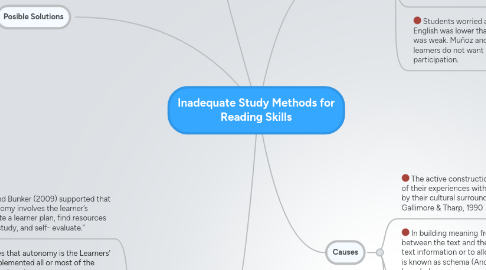Inadequate Study Methods for Reading Skills
por Juliana Cárdenas


1. Posible Solutions
1.1. Dubin and Bycina (1984) argue that reading is a selective process that occurs between the reader and the text where background knowledge and language knowledge play a very important role for comprehension.
1.2. FAMILIAR BACKGROUND INFORMATION: The text was selected because it depicted a familiar topic to the students, although not closely related to their local cultural background. A not entirely familiar text was deliberately chosen to challenge the students to use their background knowledge to uncover meaning of culturally-based information.
1.3. Weinstein and Mayer (1986) called underlining a complex rehearsal strategy. This involves selecting important ideas and marking them for subsequent review. They state that students feel a sense of security while underlining because they believe they are selecting a text’s most important ideas, monitoring their understanding while reading, and preparing the text for later review.
1.4. Test of reading comprehension in English. The test of reading compre¬hension in English was from Kit of Reading Comprehension (Rajinder S., 2008). The time allowed was 20 minutes as determined at the piloting stage. The reading passages used in this study contained a general content, which were of interest to the students.
2. Definitions
2.1. Andrade and Bunker (2009) supported that “learner autonomy involves the learner’s ability to create a learner plan, find resources that support study, and self- evaluate.”
2.2. Cofe ELT Project (1995) argues that autonomy is the Learners' responsibility for making and implemented all or most of the decisions concerning with its own learning
2.3. Autonomy is an ability, a power, a capacity to act in a given situation and not the actual behavior of an individual in that situation. It is more as a way of being that as a way of doing. Bruner (1983)
2.4. - Autonomy implies the ability to make decision about our own learning. - Autonomy involves some degree of independence from other people and from other systems normally used to control learning. - Autonomy involves thinking critically about concepts situations or people. - Autonomy means being inquisitive, wanting to find out about things before somebody else does it for you. - Autonomy implies being able to make connections between current and new knowledge. - Autonomy is about taking responsibility for one's own learning, making informed decisions, taking charge. - Autonomy is a way of being. It can be exercised in the classroom, working with others or in isolation. D. Baume, (1994)
2.5. The conscious application of cognitive strategies to comprehend reading involves possessing metacognitive skills. Metacognition has been described as “one’s knowledge concerning one’s own cognitive processes and products” (Yin & Agnes, 2001: 1) or “the process of thinking about one’s own thinking” (Tracey & Morrow, 2006: 61). Examples of metacognitive strategies applied to reading include selecting or directing one’s attention to special aspects of text, monitoring one’s comprehension of the information, selecting relevant information to remember, and evaluating one’s comprehension after completing the reading task (Fotovatian & Shokrpour, 2007).
2.6. Dubin and Bycina (1984) argue that reading is a selective process that occurs between the reader and the text where background knowledge and language knowledge play a very important role for comprehension.
3. Suggestions
3.1. Test of reading comprehension in English. The test of reading compre¬hension in English was from Kit of Reading Comprehension (Rajinder S., 2008). The time allowed was 20 minutes as determined at the piloting stage. The reading passages used in this study contained a general content, which were of interest to the students.
4. Problems
4.1. Theoretically, if there is appropriate background knowledge available and it is engaged effectively, background knowledge should serve to reduce the amount of text underlined as students focus only on marking the most important concepts (Caverly, Orlando & Mullen, 2000).
4.2. When correcting or grading students’ exercises, the teacher did not give deep feedback in theplatform, leading to limited feedback. The amount of exercises may explain why he gave limited feedback. The teacher was behind correcting the exercises and usually could not give specific academic reasons to students.
4.3. Students worried about making mistakes in public or felt that their level of English was lower than their peers and therefore interaction among students was weak. Muñoz and González (2010, p. 79), Boling (2008, p. 93) argue that learners do not want to be judged by peers or teachers and so avoid participation.
5. Causes
5.1. The active construction of knowledge by individuals as a result of their experiences with literacy, which are enabled or disabled by their cultural surroundings (Gallimore & Goldenberg, 1993; Gallimore & Tharp, 1990
5.2. In building meaning from the text, readers make connections between the text and their previous knowledge in order to assimilate text information or to allow inferential elaboration. This phenomenon is known as schema (Anderson& Pearson, 1984) or world knowledge.
5.3. Dubin and Bycina (1984) argue that reading is a selective process that occurs between the reader and the text where background knowledge and language knowledge play a very important role for comprehension.
5.3.1. Online Help
5.3.2. Use Cases & Templates
5.3.2.1. Personal Todo List
5.3.2.2. Vacation Planning
5.3.2.3. Meeting Minutes
5.3.2.4. Project Plan
5.3.2.5. more...
5.3.3. Tools and Gadgets
5.3.3.1. Offline Mode
5.3.3.2. Geistesblitz Tools
5.3.3.3. Email & SMS Gateways
5.3.3.4. Offline Mode
